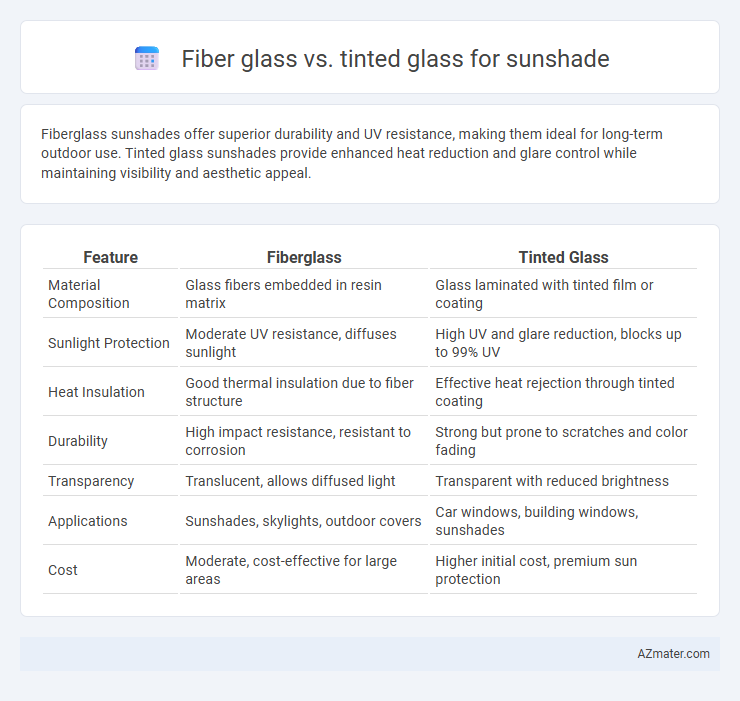Fiberglass sunshades offer superior durability and UV resistance, making them ideal for long-term outdoor use. Tinted glass sunshades provide enhanced heat reduction and glare control while maintaining visibility and aesthetic appeal.
Table of Comparison
| Feature | Fiberglass | Tinted Glass |
|---|---|---|
| Material Composition | Glass fibers embedded in resin matrix | Glass laminated with tinted film or coating |
| Sunlight Protection | Moderate UV resistance, diffuses sunlight | High UV and glare reduction, blocks up to 99% UV |
| Heat Insulation | Good thermal insulation due to fiber structure | Effective heat rejection through tinted coating |
| Durability | High impact resistance, resistant to corrosion | Strong but prone to scratches and color fading |
| Transparency | Translucent, allows diffused light | Transparent with reduced brightness |
| Applications | Sunshades, skylights, outdoor covers | Car windows, building windows, sunshades |
| Cost | Moderate, cost-effective for large areas | Higher initial cost, premium sun protection |
Introduction to Sunshade Materials
Sunshade materials such as fibre glass and tinted glass offer distinct advantages in solar protection and durability. Fibre glass is lightweight, flexible, and resistant to heat, making it ideal for versatile sunshade applications with efficient UV blocking. Tinted glass provides superior transparency with integrated UV filtration, enhancing natural light control and energy efficiency in architectural and automotive settings.
What is Fibreglass Sunshade?
Fibreglass sunshades are made from woven glass fibers coated with resin, providing excellent durability and resistance to UV rays, heat, and weather elements, making them ideal for outdoor shading solutions. Unlike tinted glass, which reduces sunlight transmission by absorbing and reflecting solar radiation, fibreglass sunshades physically block and filter sunlight through their mesh structure while allowing airflow. Their lightweight, high tensile strength and flexibility offer improved protection and comfort in both residential and commercial sunshade applications.
What is Tinted Glass Sunshade?
Tinted glass sunshade reduces solar heat gain and glare by incorporating colored or coated glass designed to absorb and reflect sunlight. Unlike fibreglass sunshades, which use a mesh or woven material to block light, tinted glass offers a permanent, transparent barrier that maintains natural visibility while enhancing energy efficiency. This type of sunshade is commonly used in windows, vehicles, and architectural applications for improved comfort and UV protection.
Thermal Performance Comparison
Fiberglass sunshades offer superior thermal insulation due to their low thermal conductivity, effectively reducing heat transfer and maintaining cooler indoor temperatures. Tinted glass absorbs and reflects a portion of solar radiation, lowering solar heat gain but often allowing more heat to pass compared to fiberglass materials. For optimal thermal performance, fiberglass shades provide enhanced energy efficiency by minimizing heat penetration better than traditional tinted glass options.
UV Protection Capabilities
Fiberglass sunshades offer moderate UV protection by filtering a significant portion of harmful rays, making them effective against sun damage and heat buildup. Tinted glass, especially with advanced UV-blocking coatings, provides superior UV protection by blocking up to 99% of UVA and UVB radiation, preventing skin damage and interior fading. When prioritizing UV protection, tinted glass outperforms fiberglass due to its enhanced ability to reduce both ultraviolet exposure and glare.
Durability and Maintenance
Fiberglass sunshades offer high durability due to their resistance to rust, corrosion, and weather damage, making them ideal for long-term outdoor use with minimal maintenance required. Tinted glass sunshades provide strong UV protection and enhanced aesthetic appeal but are prone to scratches and require regular cleaning to maintain clarity and prevent grime buildup. While fiberglass demands occasional inspection for wear or structural integrity, tinted glass necessitates careful handling and periodic polishing to avoid deterioration over time.
Aesthetic Appeal and Design Options
Fibre glass sunshades offer a sleek, modern aesthetic with a smooth, often translucent finish that complements contemporary architectural styles. Tinted glass provides a more polished and sophisticated look, enhancing building facades with varying shades and levels of opacity that contribute to energy efficiency while maintaining visual privacy. Both materials support customizable design options, though tinted glass allows for a broader range of color tones and reflective coatings to match specific aesthetic preferences.
Cost Analysis: Fibreglass vs Tinted Glass
Fibreglass sunshades generally offer a lower initial cost compared to tinted glass, making them a budget-friendly option for large-scale or temporary installations. Tinted glass, while more expensive upfront, provides enhanced durability and long-term energy savings through better heat reduction and UV protection. Over time, the increased lifespan and reduced maintenance of tinted glass can offset its higher installation price, resulting in a more cost-effective solution in commercial or permanent sunshade applications.
Environmental Impact and Sustainability
Fiberglass sunshades are made from synthetic fibers derived from silica sand and have a longer lifespan, reducing waste and minimizing environmental impact compared to tinted glass, which typically requires significant energy-intensive manufacturing processes and cannot be easily recycled. Tinted glass, although effective at blocking UV rays and reducing heat, has a higher carbon footprint due to raw material extraction and glazing energy consumption. Opting for fiberglass promotes sustainability through renewable materials and lower greenhouse gas emissions during production and disposal phases.
Choosing the Right Material for Your Sunshade
Fibre glass offers superior durability and resistance to weathering, making it an excellent choice for long-lasting sunshade frames and panels. Tinted glass provides enhanced UV protection and glare reduction while allowing natural light, ideal for sunshades where visibility and aesthetics are priorities. When choosing the right material for your sunshade, consider factors such as durability, UV protection, light transmission, and maintenance requirements to ensure optimal performance and longevity.

Infographic: Fibre glass vs Tinted glass for Sunshade
 azmater.com
azmater.com